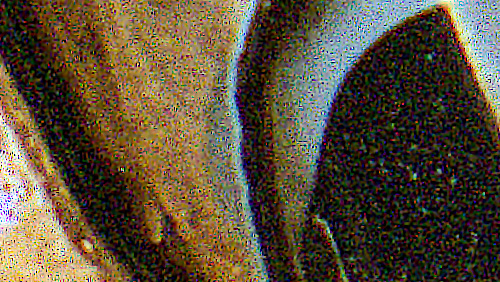Photo Corners headlinesarchivemikepasini.com
![]()
A S C R A P B O O K O F S O L U T I O N S F O R T H E P H O T O G R A P H E R
![]()
Enhancing the enjoyment of taking pictures with news that matters, features that entertain and images that delight. Published frequently.
Why Is This Man Smiling?




25 February 2015
The full width of this smiling face is jut 7/8 of an inch. Smile included. Focusing on the eyes, as you do with a portrait, we lose the nose, which appears to be somewhat more prominent that you might expect. Is that why he's smiling?

He's smiling because we're smiling. And we're smiling because we had the bright idea of revisiting some of our less pristine optical combinations with the notion of post processing them with Piccure+.
After all, that's what Piccure+is designed to do. As we said in our test drive, "It taps into the power of your computer in post processing to compensate for the inevitable compromises made in lens design."
And it needs to know nothing whatsoever about the lens to do that.
We wouldn't expect DxO to provide an Optics module for the lens combination we used for Pinocchio, for example. Piccure+, however, should have no trouble with it.
We used a Lensbaby Composer Focus Front and Tilt Transformer on a Micro Four Thirds Olympus. The Composer was fitted with a 50mm Double Glass optic but we added first a +10 macro converter lens and then a +5 macro converter to make a +15 converter.
We expected to lose a lot of sharpness and contrast but, as you can see from the comparison above, the stacked optical arrangement did pretty well. All the same, we wondered how much better Piccure+ could do.
Because we suspected sharpness would be an issue, we cranked Piccure+'s Sharpness setting well above the recommended lower setting. So the 100 percent crop below may frighten you. But the the full-frame view above should put things in context.
Our original As Shot image was derived from a DNG, which means it had to be processed by Camera Raw when opened in Photoshop. To be fair, we used the Auto correction and scaled back Exposure, Contrast and Whites to something reasonable, while adding Clarity.
So for the Piccure+ TIFF, we did the same, although it didn't required Camera Raw processing. We didn't have to make as large a change to the settings as we did for the DNG, though.
And for the full-frame images, we applied Smart Sharpening because they are a dramatic reduction.
It can be a little hard to see from the reduction above so here's an unsharpened 100 percent crop of a detail around the eye:

That's good enough to inspire us to unearth our 2x teleconverter and our old Series 1 Vivitar 70-210mm zoom. We might even try the teleconverter in between the Focus Front and the Tilt Composer, too. Because with Piccure+ we're not afraid of what would clearly be suboptimal optical stacks.
And that brings a smile to our face, too.